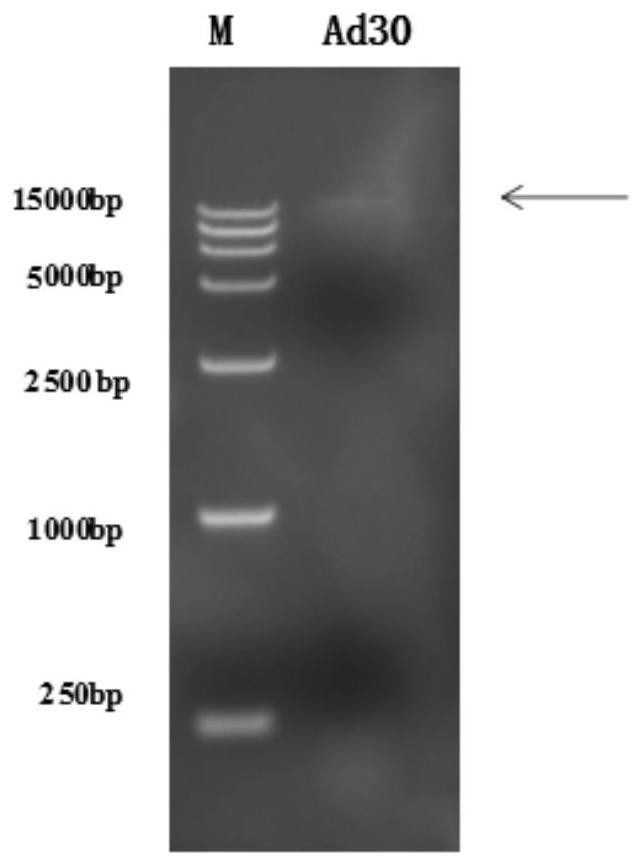Replication-defective Ad29 adenovirus vector as well as construction method and application thereof
A replication-deficient type and construction method technology, applied in the field of replication-deficient Ad29 adenovirus vector and its construction, can solve the problems of complicated and time-consuming operation
- Summary
- Abstract
- Description
- Claims
- Application Information
AI Technical Summary
Problems solved by technology
Method used
Image
Examples
Embodiment 1
[0084] Example 1 Obtaining of human adenovirus type 29 genome
[0085] 1. Selection of human adenovirus type 29 adenovirus
[0086] The trans complement cell line of human adenovirus type 5 E1 deletion vector is HEK293. HEK293 cells are derived from human embryonic kidney cells. The E1A and E1B genes of human adenovirus type 5 are inserted into the cells, and the nucleotide sequence is 1 to 4344bp , the insertion site is the q13.2 region of chromosome 19.
[0087] A disadvantage of the HEK293 cell line is the possible contamination of the virus preparation with restorer mutations (RCA). This is because the 400th to 3500th base of the first-generation Ad5 vector is knocked out, but still maintains significant homology with the cellular DNA, and a double-crossover recombination event will occur to generate wild adenovirus.
[0088] In order to prevent the production of RCA, there are two ways, one is to construct a cell line containing only 505-4034 bases of human adenovirus t...
Embodiment 2
[0096] Example 2 Containing Fluorescent Labeled Adenovirus Shuttle Plasmid Construction
[0097] The human adenovirus type 29 genome is a linear DNA with a length of about 35,000 bp, and it is difficult to carry out effective molecular manipulation on it. Therefore, it is necessary to connect the elements related to replication in bacteria, the replicon (pACYC), and the resistance gene (kanamycin), to the left ~ 1400bp fragment of the Ad29 genome, and the right ~ 1400bp fragment, through homologous recombination in BJ5183 competent , constituting a circular plasmid, which can effectively replicate in bacteria; at the same time, in order to monitor the transfection efficiency of the plasmid in cells, a green fluorescent expression cassette (RSV promoter, EGFP, BGHpolyA) was added, and the TPO after transfection into cells The transfection efficiency of the large vector can be judged by the amount of fluorescence.
[0098] 1. Construction of the shuttle plasmid pAd29-shuttle fo...
Embodiment 3
[0121] Example 3 CRISPR / cas9 excision of Ad29 adenovirus E1 region
[0122] Ad29 replication-related genes are E1, E3, and E4 genes. E1 gene is adjacent to PIX. E1 gene is composed of E1A, E1B and their related promoter genes. Its upstream is the non-structural protein region, and its downstream position is PIX gene. It is a non-open reading frame and does not encode a protein. Use specific gRNA and Cas9 protein to cleave the double-stranded DNA of the E1 gene and the double-stranded DNA of the non-open reading frame downstream of the PIX gene, and realize the knockout of the E1 gene by double enzyme digestion, while using the human HPRT intron gene The excised sequences were ligated as nonsense sequences (stuff sequences) to obtain an Ad29 plasmid with E1 gene deletion, which was named pAd29ΔE1. The HPRT intron gene sequence is an intron of the human genome, which does not encode amino acids and does not express any genes, so it will not affect the packaging of adenovirus an...
PUM
 Login to View More
Login to View More Abstract
Description
Claims
Application Information
 Login to View More
Login to View More - R&D
- Intellectual Property
- Life Sciences
- Materials
- Tech Scout
- Unparalleled Data Quality
- Higher Quality Content
- 60% Fewer Hallucinations
Browse by: Latest US Patents, China's latest patents, Technical Efficacy Thesaurus, Application Domain, Technology Topic, Popular Technical Reports.
© 2025 PatSnap. All rights reserved.Legal|Privacy policy|Modern Slavery Act Transparency Statement|Sitemap|About US| Contact US: help@patsnap.com



